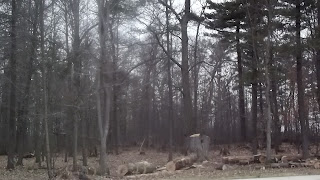Is it possible not to destroy our few remaining Shawano
forest remnants?
A friend of mine and I launched a 15’ aluminum open fishing
boat on the Wolf River below the Hwy 22 bridge in Shawano and rowed to Oshkosh. It took 7 days. The
first half mile we had to walk alongside the boat as the water was barely 6”
deep in places. Imagine, at one time
ferry boats steamed up to Shawano on the Wolf River from Black Creek. What had
happen from those days to the time we launched?
For one thing millions of acres of forest were logged off and the
resulting sedimentary runoff filled in the river bottom making the navigation
of the larger water craft impossible.
Within the City of Shawano a few small remnants our expansive
forests remain to our time. But will
they survive our deep cultural and traditional activities or will they be left
alone to continue to regenerate?
Brener Woods is an example of one of those tiny remnants. Collectively owned by the citizens of Shawano,
it is presently being slowly transformed from an urban forest to ‘a lawn with trees’,
its ecology and microbial soil composition permanently altered.
It appears someone, one of us, had complained: The walking trails are too narrow, they have
now been over time widened to where a truck could be driven through them.
There is too much
brush, it looks ‘untidy’ (necessary forest ground growth and valuable
understory that enables future regeneration). One of us complained: Some students are
hiding there doing who knows what! Solutions for these: The forest is being systematically
brushed out.
A tree or limb could fall on someone. Solution: The dead and dying trees are being
removed. For generations the aging trees
and limbs were ‘allowed’ to naturally return soil, they were homes for certain
birds, animals and plants and generally rejuvenated the soil. Cut and hauled away, much of the nutrients
from the soil are taken, further weakening the ability of the forest to
regenerate. These standing dead trunks
are called by the derogatory name ‘snags’ but really so valuable that in our
National Forests it is now illegal to cut them.
If we cannot get ourselves to stop, the entire woods as time
progresses will continue to be degraded: The trees will age and will be cut and
removed with no hope of regenerating because the grown cover and understory
will continued to be removed. Even the stumps may be removed furtherr removing nutrients. Perhaps one of us
in the future may suggest paving the trails, perhaps one of us will want a pavilion
built and later one of us may suggest cutting the trees away from the pavilion to
prevent damage. There is no mechanism in
place to stop this.
But perhaps one of us will suggest leaving it alone. If we cannot control our behavior within a woods,
perhaps one of us will suggest building a protective fence around it. Perhaps one of us will suggest the
unthinkable, though not unreasonable: delineating areas of the overabundant open grass around the forest so these tiny remnants may naturally expand and in
the future those areas could be even expanded more.
But our deep cultural traditions, if not questioned and
altered may prevent this remnant’s ability to survive beyond our own generation.
1st Step Present Conversion Activity from Natural Forest to a Treed Lawn
Tiny Urban Woods, still a Natural Forest, Surrounded by Manicured Lawn

